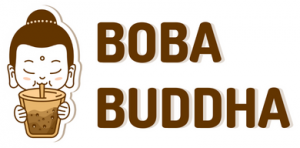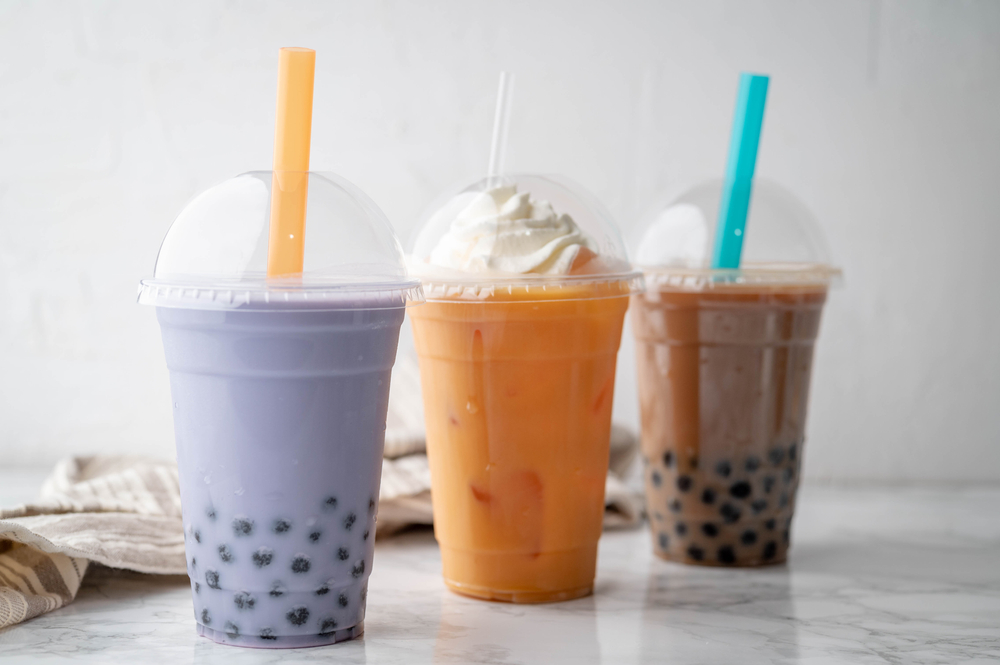Many boba teas are made with black tea, which has between 47 and 90 mg of caffeine per cup. On average, one boba tea serving contains 50 mg of caffeine. However, using different types of tea can lower the caffeine content. Keep reading to learn how to customize your tea.
What Kind of Tea Is Used in Boba Tea?
The two most common bubble tea bases are green and black tea. If you are watching your caffeine intake, you don’t need to change your entire bubble tea order—just change the tea base. However, it is vital to remember that many milk tea powders contain caffeine.
Traditional milk teas are made with a cup of black tea, but they can also be made with herbal tea, green tea, oolong tea, or Thai tea. Tapioca pearls form the base of boba tea, followed by sweetened milk or creamer, and then brewed tea.
Sometimes boba is made with fresh fruit and fruit tea. Fruit boba doesn’t need tea—tapioca pearls can be topped with fruit puree or syrup, plenty of ice, and sweetener.

Which Type of Tea Has the Most Caffeine?
The amount of caffeine varies according to the type of tea, how long you steep it, and how much tea you use.
| Per 8 oz | Caffeine |
| Assam tea | 60-112 mg |
| Black tea | 27-90 mg |
| Oolong tea | 37-55 mg |
| Green tea | 20-45 mg |
| Matcha tea | 25-35 mg |
In comparison, one cup of coffee contains between 80 and 110 mg of caffeine.
Which Type of Tea Has the Least Caffeine?
The teas listed below have less caffeine than other varieties. If you are caffeine sensitive, use one of these teas to make your bubble tea. They have low or no caffeine and should be safe to enjoy in the afternoon or evening without disrupting sleep.
| Per 8 oz | Caffeine |
| Jasmine tea | 15-60 mg |
| White tea | 6-60 mg |
| Decaf tea | 0-12 mg |
| Herbal tea | 0 mg * |
* If you are avoiding caffeine, ensure the herbal tea is pure and isn’t mixed with black or green tea.
Taro, a popular bubble tea flavor, is naturally caffeine free. Use taro powder, from the taro root vegetable commonly found in Asia, to make a unique caffeine-free milk tea.
Does Fruit Bubble Tea Have Caffeine?
Many fruit teas are made with green tea. While green tea has a low amount of caffeine, it is possible to make fruit bubble tea without caffeine.
To do so, just leave out the tea. Blend or shake fruit juice, fresh or frozen fruit, or powder with milk and sweeteners to form the base of fruit bubble tea. Add the fruit mixture to sweetened tapioca pearls to create caffeine-free fruit bubble tea.
Will Boba Keep You Awake?
The answer is different for every person. Your body absorbs the caffeine in tea differently from the caffeine in coffee. Coffee is pure caffeine, which often leads to a burst of energy and a crash. Tea, however, contains the amino acid L-theanine in addition to caffeine. This amino acid helps slow the absorption of caffeine in the bloodstream. So, instead of a burst of energy, tea provides a steadier increase in energy levels, which can help you focus for extended periods.
Some people can tolerate tea later in the day or the evening, while others can’t. So, if you are sensitive to caffeine, you should plan to finish any caffeinated drinks before 2 pm.
Does Steeping the Tea Longer Increase the Caffeine Content?
Yes, the longer the tea steeps, the higher the caffeine content will be. Many bubble tea shops let their tea steep for several hours, so the tea flavor stands out in the finished boba tea.

The caffeine content in tea is also affected by the following:
The temperature of the water: the hotter the water, the more caffeine the leaves will release
The amount of tea: the more tea bags or tea leaves you use will create a higher caffeine tea
The type of tea: as discussed above, each tea has a different caffeine level
The size of the tea leaves: small tea leaves release caffeine more quickly than large tea leaves

